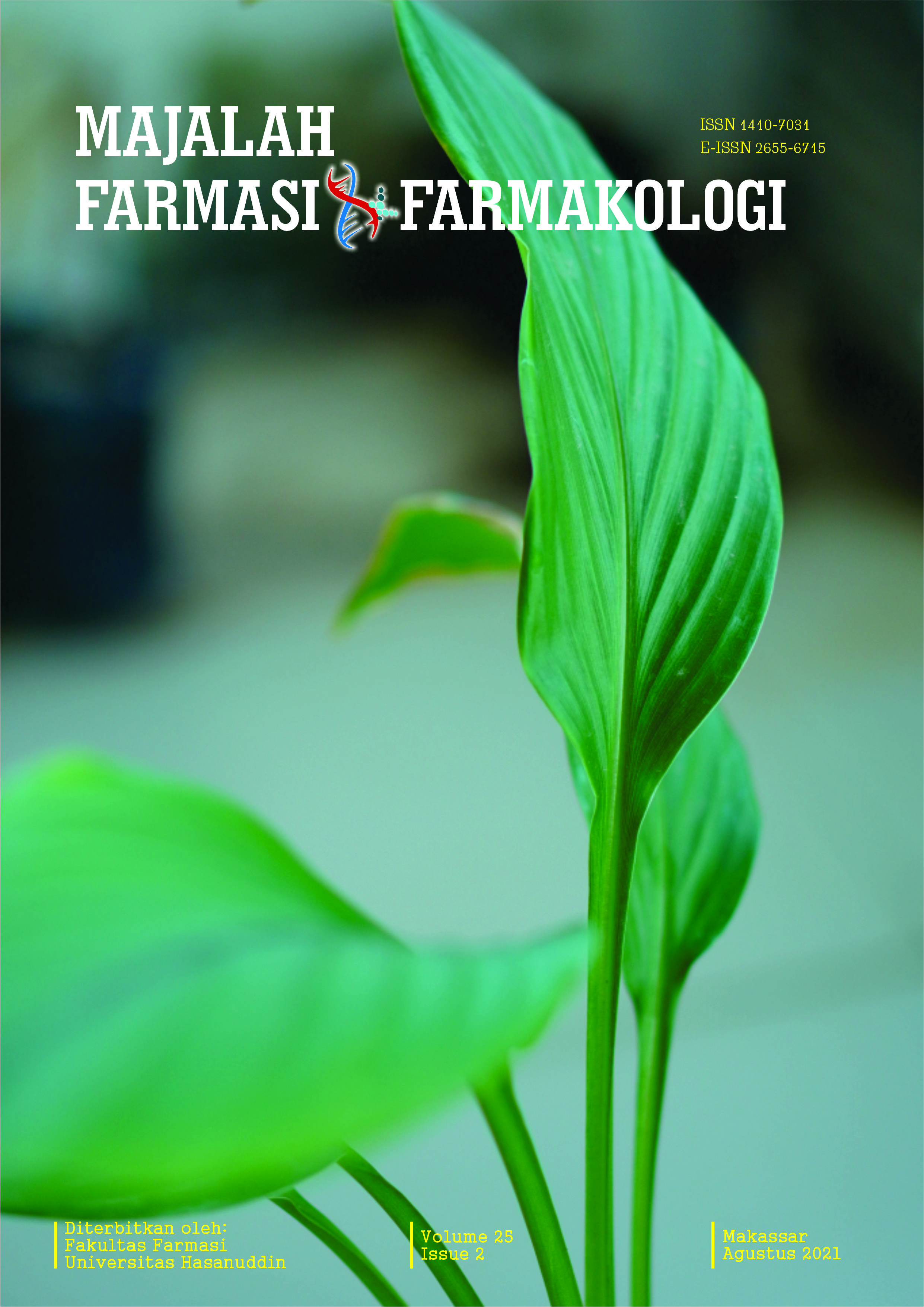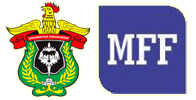ISOLASI FUNGI ENDOFIT DARI DAUN ASAM JAWA (Tamarindus indica L.) SEBAGAI PENGHASIL SENYAWA ANTIBAKTERI
Keywords:
antibakteri, fungi endofit, Tamarindus indica L.Abstract
Fungi endofit merupakan sekelompok jamur yang sebagian atau seluruh hidupnya berada dalam jaringan tumbuhan hidup dan biasanya tidak merugikan pada inangnya. Fungi endofit umumnya memproduksi metabolit sekunder yang memiliki aktivitas biologis yang bermanfaat seperti misalnya senyawa-senyawa anti kanker, antivirus, atau antibakteri. Penelitian ini bertujuan untuk mengisolasi fungi endofit dari daun T. indica L. serta menguji aktivitas antibakteri metabolit sekunder fungi endofit yang diperoleh terhadap Escherichia coli dan Staphylococcus aureus. Proses isolasi fungi endofit menghasilkan 1 isolat yang diberi kode TID-1. Produksi senyawa antibakteri dilakukan melalui proses fermentasi isolat fungi endofit TD-1 selama 18 hari pada kondisi teragitasi menggunakan medium PDYdari isolat TID-1. Pada akhir proses fermentasi, media fermentasi diekstraksi dengan etil asetat dan biomassa diekstrasi dengan metanol. Uji aktivitas antibakteri ekstrak etil asetat dengan konsentrasi ekstrak 200 ppm/disk, 300 ppm/disk, dan 400 ppm/disk mampu menghambat pertumbuhan E. coli sebesar 8.43 mm, 9.6 mm, dan 10.86 mm. Pada konsentrasi 300 ppm/disk dan 400 ppm/disk menghambat pertumbuhan S. aureus sebesar 10,11 mm dan 12,8 mm, sedangkan ekstrak metanol tidak memberikan aktivitas antibakteri., sehingga dapat disimpulkan bahwa metabolit sekunder fungi endofit yang diisolasi dari daun asam jawa (T . indica L.) berpotensi sebagai penghasil senyawa antibakteri.
References
Strobel G, Daisy B. Bioprospecting for microbial endophytes and their natural products. Microbiology and Molecular Biology Reviews. 2003; 67(4): 491-502.
Poeloengan M, Adriani, Susan MN, Komala I, Hasnita M. Uji Daya Antibakteri Ekstrak Etanol Batang Bungur (Largerstoremia Spesiosa Pers) terhadap Staphylococus aureus dan Eschericia coli. Universitas Pancasila. Jakarta. 2007.
Widya S, Aktivitas A ntibakteri Dari Ekstrak Etanol Daun Asam Jawa (Tamarindus indica Linn.) Terhadap Kultur Aktif Staphylococcus Aureus dan Escherichia Coli. Universitas Islam Negeri (Uin) Syarif Hidayatullah. Jakarta. 2010.
Adeniyi OV, Olaifa FE, Emikope BO, and Ogunbanwo ST. Phytochemical components and antibacterial activity of Tamarindus indica Linn, extracts against some patogens. Biotechnology Journal International. 2017; 1-9.
Rante H, Yulianty R, Evary YM, Hardiana E. Isolation and antibacterial activity of endophytic fungi from Melochia umbellata (Houtt). Journal of Pure and Applied Microbiology. 2017; 11(3), pp. 1313–1318
Inamandar AC, Paliit A. The Genus Malassezia and human disease. Indian J. Dermatol Venereol Leprol. 2003; 69:265-70
Burhamzah R, Alam G, Rante H. Characterization of antibacterial-producing endophytic fungi of syzygiumpolyanthum leaves. Infectious Disorders - Drug Targets. 2020; 20(4): 448–454
Liu CH, Zou WX, Lu H, Tan RX. Antifungal activity or Artemisia annua endophyte cultures against phytopathogenic fungi, The Journal of Biotechnology. 2001; 88: 277-282.
Daud NH, Jayaraman S, Mohamed R. An improved surface sterilization technique for introducing leaf, nodal and seed explants of Aquilaria malaccensis from field sources into tissue culture. Asia-Pacific Journal of Molecular Biology and Biotechnology. 2012; 20(2):55-5
Pratiwi ST. Mikrobiologi Farmasi, Erlangga, Jakarta; 2008.
Rante H, Taebe B, Intan S. Isolasi Fungi Endofit Penghasil Senyawa Antimikroba Dari Daun Cabai Katokkon (Capsicum Annuum L Var. Chinensis) Dan Profil Klt Bioautografi. Majalah Farmasi dan Farmakologi. 2013; 17(2): 39-45
Mawaddah R. Kajian Hasil Riset Potensi Antimikroba Alami dan Aplikasinya dalam Bahan Pangan. Pusat Informasi Teknologi Pertanian Fateta IPB. Fakultas Teknologi Pertanian Institut Pertanian Bogor. 2008.
Downloads
Published
Issue
Section
License
Copyright (c) 2021 Majalah Farmasi dan Farmakologi

This work is licensed under a Creative Commons Attribution-NonCommercial 4.0 International License.
The copyright to this article is transferred to Universitas Hasanuddin (UNHAS) if and when the article is accepted for publication. The undersigned hereby transfers all rights in and to the paper including without limitation all copyrights to UNHAS. The undersigned hereby represents and warrants that the paper is original and that he/she is the author of the paper, except for material that is clearly identified as to its original source, with permission notices from the copyright owners where required. The undersigned represents that he/she has the power and authority to make and execute this assignment.
We declare that:
- This paper has not been published in the same form elsewhere.
- It will not be submitted anywhere else for publication prior to acceptance/rejection by this Journal.
- A copyright permission is obtained for materials published elsewhere and which require this permission for reproduction.
Furthermore, I/We hereby transfer the unlimited rights of publication of the above-mentioned paper in whole to UNHAS The copyright transfer covers the exclusive right to reproduce and distribute the article, including reprints, translations, photographic reproductions, microform, electronic form (offline, online) or any other reproductions of similar nature.
The corresponding author signs for and accepts responsibility for releasing this material on behalf of any and all co-authors. This agreement is to be signed by at least one of the authors who have obtained the assent of the co-author(s) where applicable. After submission of this agreement signed by the corresponding author, changes of authorship or in the order of the authors listed will not be accepted.


